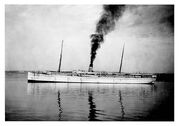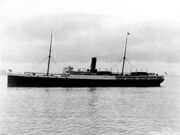The SS Victoria was a coastal ocean liner owned by the Alaska Steamship Company. Both the liner and the company were based in and out of Seattle. She was built in 1870 as the Parthia before becoming the Victoria. After over 80 years of service, Victoria was converted into a barge on Lake Washington and was later scrapped in Osaka, Japan.

SS Victoria in her days as the Cunard Liner Parthia.
Victoria was constructed between February 2 and about November in 1870 as the transatlantic liner Parthia for the British shipping giant, Cunard Line (later the owners of the ill fated Lusitania). Like many vessels of her type and time, Parthia was built on the River Clyde. Her builders were William Denny & Brothers shipyard in Dumbarton, Scotland and her hull number was 148. Parthia was a smaller sister ship to the Abyssinia and Algeria, but unlike her sisters, was slightly smaller and carried a more efficient compound steam engine. Due to this, Parthia required less space for coal storage and was able to utilize more room for cargo.
In 1871, Parthia was already considered outdated in the eyes of technological progress. Cunard's rival, the White Star Line (later known for being the owners of Titanic) began operations with the new Oceanic. Most of Cunard's vessels, including the Abyssinia and Algeria carried far less passengers and burned more tons of coal per day than Oceanic. Luckily, Parthia, although less advanced than the Oceanic, still burned far fewer tons of coal per day and was thus able to hold her own for the next few years. Between 1871 and 1883, Parthia saw a somewhat colorful career. She rescued the survivors of two sunken sailing vessels and transported troops in the Mahdist War between Britain and Sudan. She had aslo been involved in a collision with the White Star vessel Adriaticnear New York City. The latter vessel was well known throughout her career for causing collisions with other ships.
By 1883 however, Parthia was finally viewed too old and outdated by Cunard Line standards. Her sister, Abyssinia, had been sold to the Guion Line only years earlier. Thus, Parthia made her 119th and last crossing for Cunard in November of that year. Percieving new ambitions, Cunard had ordered two new record breaking liners from John Elder & Company; the Umbria and Etruria. The company had also made plans to purchase the ex-Guion greyhound Oregon. The Oregon had been returned to her builders, the aforementioned shipyard, due to Guion's inability to deliver payments. To help cover the cost of the three new vessels, Cunard traded Parthia to John Elder.
Although her days with Cunard were over, her new owners had plans for the liner. She was sold to the Guion Line and was re-united with her sister ship Abyssinia. To prepare her for Guion service, John Elder fitted Parthia with brand new triple expansion steam engines and pressurized boilers. Her coal consumption was thus cut almost in half. After a brief charter by the British Admiralty in a failed attempt to save General Charles Gordon, Parthia entered Guion Line service between Australia, Scotland and South America. In 1887, the Candian Pacific Railway was nearing completion to the western port of Vancouver. Needing ships to begin service between Vancouver and Japan, CPR chartered the Parthia and Abyssinia from Guion to begin this service.
In 1890, the British government launched a subsidy agreement with CPR. Three new ships, the Empress of Japan, Empress of Chinaand Empress of India, were to be constructed for CPR. The trio would serve along a newly appointed mail contract between Vancouver and Yokohama, via Hong Kong and would serve as cruisers in times of war. Recieving the three Royal Mail Steamers the next year, CPR returned Parthia to the Guion Line. However, Guion had no further use for the Parthia. While laid up at the John Elder yard, Parthia was sold to the Tacoma based Northern Pacific Steamship Company and renamed Victoria. She underwent a massive refit, which added superstructure to her hull, removed her mizzen mast and partially enclosed her bridge. In 1892, Victoria returned to the Pacific Northwest. She would never see Britain, the Atlantic Ocean or her sister ship Abyssinia ever again.

SS Victoria, beginning service with the Alaska Steamship Company.
Although now operated between Hong Kong and Tacoma by an American company, Victoria still flew the British ensign. In 1898 however, she was sold to the North American Mail Steamship Company, finally changing registry to the American flag. This made Victoria the oldest ship in the American Merchant Marine. In 1891, she served as a troopship in the Spanish American War between the Phillipines and San Francisco, completing six voyages. In 1905, Victoria supported the port of Vladivostok as a blockade runner during the Russo-Japanese War. After serving with a myriad of different owners between 1900 and 1904, the Victoria ultimately ended up with the Alaska Steamship Company of Seattle in 1908. Although she was 38 years old, the Alaska Steamship Company saw opportunity in Victoria. The liner was placed in Coastal service between Nome and San Francisco via Seattle. Eventually, the nickname "Old Vic" would become synonymous with the vessel all over Seattle.

Victoria sometime after 1924. The owner of this photo has released it into the public domain.
During World War I, Victoria carried massive amounts of precious cargo on her regular route, earning the Alaska Steamship Company excess profit. In 1924, Victoria was rebuilt with modern superstructure, a completely enclosed bridge and oil fired boilers. The newly refurbished Victoria served alongside the similar sized Alaska, Aleutian and Yukon in service to Alaska. In 1934, Victoria embarked on the company's first Alaskan cruise, calling to Nome and Kotzebue and travelling westward to a massive ice shelf near Siberia. That same year, the ocean liner Morro Castle of the Ward Line caught fire off New Jersey, killing over 100 people. New fire regulations and restrictions were weighed down on all American flagged vessels. The new restrictions in part with the Great Depression spelled the beginning of the end for Victoria. Between 1935 and 1938, she was laid up in the middle of Lake Union, sandwiched between massive cargo ships which dwarfed her in size. She returned to passenger service breifly, before being converted into a cargo only vessel in 1941. In response to the U.S. entry into World War II, she was used by the U.S. War Administration to carry valuable cargo between Alaska and Seattle until 1947. Her bell was returned to Cunard in 1950 for use on their passenger/cargo vessel Parthia.
The Alaska Steamship Company continued to use Victoria as a cargo ship until 1952. In 1953, the self-proclaimed treasure expert, Harry Rieseberg, considered the Victoria as a possible vessel for an idea he had for a floating treasure museum. [1]She was sold to Dulien Steel Products in 1954 and was towed to Houghton on the south end of Lake Washington for scrapping. Instead, her 80 year old hull was discovered to be in fantastic shape. In repsonse, Victoria's superstructure was cut down to the main deck and she was converted into a barge. She left Seattle for the last time and arrived in Vancouver in 1955. Renamed Straits No. 27, she served with the Vancouver based Straits Towing and Salvage Company carrying lumber. After only one year of service, she was sold to shipbreakers in Osaka and renamed Straits Maru. Her 86 year old Swedish hand wrought iron plates were torn apart.
To this day, no other ocean liner has had an extensive career matching that of "Old Vic". Victoria's bell is currently preserved by MOHAI. A model of the Victoria is on display at the Puget Sound Maritime Museum near Lake Union. Today the Colman Dock, which Victoria used in her earlier Seattle years, is constantly used by ferryboats which cross Puget Sound. The part of the dock where Victoria used to embark from has been filled in and is currently a parking lot.
- ↑ "Rieseberg May Buy Victoria," The Seattle Times, p 33, March 6, 1953.